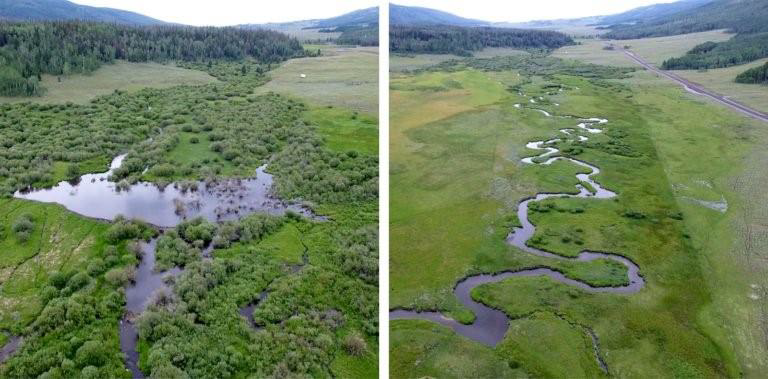
Beaver engineered wetlands - same river: with
beaver (left) and without (right)
The Eurasian Beaver, successfully re-introduced into many European countries, is now well and truly re-established in Scotland. This is welcomed by many environmentalists but worries some farmers and fisheries managers. For now, it is still restricted in its range being found in the Knapdale, Argyll, where it was experimentally introduced, and in the Tay catchment, where it was apparently released by guerrilla beaver lovers. While there are only a dozen animals in Knapdale there are estimated to be between around 1000 on the Tay and its tributaries, and now also in the Forth catchment. A recent NatureScot survey showed that the number of beavers in Scotland has more than doubled in the last three years between 2017 and 2020 and the beavers were spotted in 251 territories including Tayside, Stirling, Forfar and Crianlarich. NatureScot believes that they are likely to expand into Loch Lomond in the future.
 |
|
Beaver engineered wetlands - same river: with
beaver (left) and without (right) |
The presence of beaver in Scotland raises passionate arguments from both its supporters and its detractors. It is well known as an ecosystem engineer, changing the environment around it through dam-building, creating wetlands and providing a much more diverse habitat for many other species. It may well help to control flooding and improve water quality through the chains of ponds and wetlands they build in river floodplains. On the other hand, beavers do sometimes damage flood banks protecting agricultural land by burrowing into them and fell trees considered to be important for riverine landscapes. They may accelerate natural riverbank erosion in certain situations. They do not eat fish, despite some uneducated claims for this, and are entirely vegetarian, eating a variety of plants and, in winter, the inner bark of trees. Despite some potential downsides beaver now have legal protection in Scotland. It is an offence to kill or trap the animals or destroy their dams and lodges.
However, NatureScot will grant licences to manage beaver populations where damage is deemed unacceptable, for example, to agricultural flood defences. Such licences include killing the animals and in 2020, while 31 were trapped and translocated to England, 117 beaver had been culled and there is strong suspicion that more have been killed or lodges destroyed through unlicensed activity. Not surprisingly, any culling is strongly opposed by environmental NGOs and beaver supporters who point out that translocation to new areas could be a better option and that there are a number of techniques for preventing beaver damage without culling them.
So, what’s likely to be the future for beavers? The Scottish Government policy is to allow the two current populations to expand their ranges naturally but it is still illegal to deliberately introduce them to new river catchments. Over time it is inevitable that beaver will expand into new areas though the rate will depend on connectedness of waterways and the nature of barriers between watersheds. A study in Sweden showed that beaver populations had moved up to 305km in 25 years, including across watersheds. A Scottish Natural Heritage survey showed that there are over 100,000 hectares of potential core beaver woodland in Scotland and some landowners and NGOs are very keen to have beavers in their areas. It is clear that any policy change to allow such translocations will very much depend on what NatureScot learns about beaver management and how to allay the fears of farmers and land managers.
Where riverside woodlands are well established beaver populations would undoubtedly aid the generation of much more diverse habitats through new wetlands, open areas and low thickets of coppiced trees while trapping sediment, adding woody debris to rivers and slowing flood flows. There are many areas of NE Scotland where these conditions are already present and beaver could be happily supported. It is likely though that measures to control beaver activity in more fragile areas would be required for general acceptance.
Please let the webmaster know if there are problems with viewing these pages or with the links they contain.